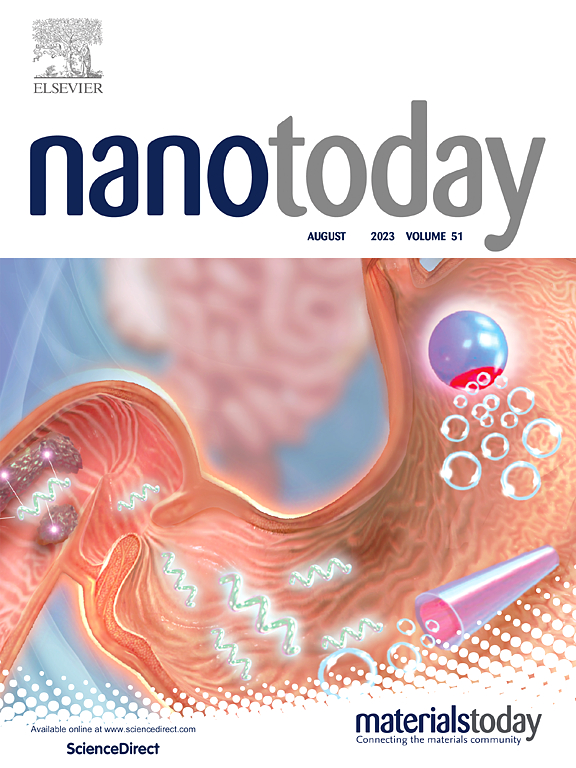完全非手性结构单元构建的超分子纳米组装体中的光学活性持久荧光
IF 13.2
1区 材料科学
Q1 CHEMISTRY, MULTIDISCIPLINARY
引用次数: 0
摘要
光学活性持久发光材料因其独特的发光特性和展现丰富圆偏振信息的能力而备受关注。尽管人们在利用手性分子或聚合物开发圆偏振持久发光(CPPL)材料方面做出了大量努力,但利用非手性单元制造 CPPL 材料仍然是一个巨大的挑战。在这项工作中,我们介绍了一种利用完全非手性有机分子制造 CPPL 材料的高效共组装策略。共组装复合物的光学活性归因于结构的手性,而结构的手性来自于 C3 对称分子自组装过程中对称性破坏时形成的手性纳米螺旋。具有持久磷光的手性分子可通过氢键粘附到这些手性纳米结构上,并在干燥阶段形成沿螺旋纤维排列的纳米晶体,从而产生圆偏振的持久磷光。通过氢键驱动的共组装实现了更高的 CPPL 效率,其范围从蓝色到黄色,不对称系数超过 1.2 × 10-2,室温下的寿命长达 0.6 秒。此外,还利用自制的时间分辨圆偏振长余辉探测平台捕获了这些共组装体的 CPPL 光谱。这项研究不仅为利用非手性构件高效设计 CPPL 材料提供了一种新方法,而且极大地拓宽了实时 CPPL 分析的研究领域,为 CPPL 材料的探索开辟了新天地。本文章由计算机程序翻译,如有差异,请以英文原文为准。
Optically active persistent luminescence in supramolecular nanoassemblies constructed from entirely achiral building blocks
Optically active persistent luminescent materials have attracted significant attention due to their distinctive luminescent characteristics and ability to exhibit rich circular polarization information. Despite extensive efforts to develop circularly polarized persistent luminescence (CPPL) materials using chiral molecules or polymers, fabricating CPPL materials from achiral units remains a big challenge. In this work, we introduce an efficient co-assembly strategy to create CPPL materials using entirely achiral organic molecules. The optical activities of co-assembled complexes are attributed to structural chirality, which arises from chiral nanohelices formed during symmetry breaking in the self-assembly process of C3-symmetric molecules. Achiral molecules with long-lasting phosphorescence can adhere to these chiral nanostructures via hydrogen bonding, and during the drying phase, form nanocrystals that align along helical fibers, resulting in circularly polarized, long-lasting phosphorescence. Enhanced CPPL efficiency, ranging from blue to yellow with a dissymmetry factor over 1.2 × 10−2 and lifetime of up to 0.6 s at room temperature, is achieved through hydrogen bonding driven co-assembly. Additionally, the CPPL spectra of these co-assemblies are captured using a homemade time-resolved circularly polarized long afterglow detection platform. This study not only presents a new approach for the high-efficiency design of CPPL materials from achiral building blocks but also significantly broadens the research possibilities in real-time CPPL analysis, offering a horizon in the exploration of CPPL materials.
求助全文
通过发布文献求助,成功后即可免费获取论文全文。
去求助
来源期刊

Nano Today
工程技术-材料科学:综合
CiteScore
21.50
自引率
3.40%
发文量
305
审稿时长
40 days
期刊介绍:
Nano Today is a journal dedicated to publishing influential and innovative work in the field of nanoscience and technology. It covers a wide range of subject areas including biomaterials, materials chemistry, materials science, chemistry, bioengineering, biochemistry, genetics and molecular biology, engineering, and nanotechnology. The journal considers articles that inform readers about the latest research, breakthroughs, and topical issues in these fields. It provides comprehensive coverage through a mixture of peer-reviewed articles, research news, and information on key developments. Nano Today is abstracted and indexed in Science Citation Index, Ei Compendex, Embase, Scopus, and INSPEC.
 求助内容:
求助内容: 应助结果提醒方式:
应助结果提醒方式:


